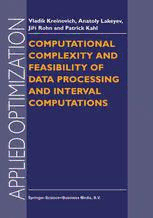
Computational Complexity and Feasibility of Data Processing and Interval Computations PDF
Preview Computational Complexity and Feasibility of Data Processing and Interval Computations
Computational Complexity and Feasibility of Data Processing and Interval Computations Applied Optimization Volume 10 Series Editors: Panos M. Pardalos University oiF lorida, U.S.A. Donald Hearn University oiF lorida, U.SA. The titles published in this series are listed at the end 0/ this volurne. Computational Complexityand Feasibility of Data Processing and Interval Computations by Vladik Kreinovich University ofTexas at EI Paso, Texas, U.S.A. Anatoly Lakeyev Computing Center, Russian Academy of Sciences, Irkutsk, Russia JiiiRohn Charles University and Academy of Sciences, Prague, Czech Republic Patrick Kahl IBM, Tueson, Arizona, U.S.A. Springer-Science+Business Media, B.V. A C.I.P. Catalogue record for this book is available from the Library of Congress. ISBN 978-1-4419-4785-7 ISBN 978-1-4757-2793-7 (eBook) DOI 10.1007/978-1-4757-2793-7 Printed on acid-free paper All Rights Reserved © 1998 Springer Science+Business Media Dordrecht Originally published by Kluwer Academic Publishers in 1998. Softcover reprint ofthe hardcover 1st edition 1998 No part of the material protected by this copyright notice may be reproduced or utilized in any form or by any means, electronic or mechanical, inc1uding photocopying, recording or by any information storage and retrieval system, without written permission from the copyright owner. CONTENTS PREFACE IX 1 INFORMAL INTRODUCTION: DATA PROCESSING, INTERVAL COMPUTATIONS, AND COMPUTATIONAL COMPLEXITY 1 2 THE NOTIONS OF FEASIBILITY AND NP-HARDNESS: BRIEF INTRODUCTION 23 3 IN THE GENERAL CASE, THE BASIC PROBLEM OF INTERV AL COMPUTATIONS IS INTRACTABLE 41 4 BASIC PROBLEM OF INTERV AL COMPUTATIONS FOR POLYNOMIALS OF A FIXED NUMBER OF VARIABLES 53 5 BASIC PROBLEM OF INTERVAL COMPUTATIONS FOR POLYNOMIALS OF FIXEDORDER 71 6 BASIC PROBLEM OF INTERV AL COMPUTATIONS FOR POLYNOMIALS WITH BOUNDED COEFFICIENTS 79 v VI COMPLEXITY OF INTERVAL COMPUTATIONS 7 FIXED DATA PROCESSING ALGORITHMS, VARYING DATA: STILL NP-HARD 83 8 FIXED DATA, VARYING DATA PROCESSING ALGORITHMS: STILL INTRACTABLE 85 9 WHA T IF WE ONLY ALLOW SOME ARITHMETIC OPERATIONS IN DATA PROCESSING? 87 10 FOR FRACTIONALLY-LINEAR FUNCTIONS, A FEASIBLE ALGORITHM SOLVES THE BASIC PROBLEM OF INTERV AL COMPUTATIONS 91 11 SOLVING INTERV AL LINEAR SYSTEMS IS NP-HARD 99 12 INTERV AL LINEAR. SYSTEMS: SEARCH FOR FEASIBLE CLASSES 111 13 PHYSICAL COROLLARY: PREDICTION IS NOT ALWAYS POSSIBLE, EVEN FOR LINEAR SYSTEMS WITH KNOWN DYNAMICS 143 14 ENGINEERING COROLLARY: SIGNAL PROCESSING IS NP-HARD 153 15 BRIGHT SIDES OF NP-HARDNESS OF INTERV AL COMPUTATIONS I: NP-HARD MEANS THAT GOOD INTERV AL HEURISTICS CAN SOLVE OTHER HARD PROBLEMS 159 Contents VII 16 IF INPUT INTERVALS ARE NARROW ENOUGH,THENINTERVAL COMPUTATIONS ARE ALMOST ALWAYS EASY 161 17 OPTIMIZATION - A FIRST EXAMPLE OF A NUMERICAL PROBLEM IN WHICH INTERV AL METHODS ARE USED: COMPUTATIONAL COMPLEXITY AND FEASIBILITY 173 18 SOLVING SYSTEMS OF EQUATIONS 197 19 APPROXIMATION OF INTERVAL FUNCTIONS 207 20 SOLVING DIFFERENTIAL EQUATIONS 219 21 PROPERTIES OF INTERVAL MATRICES I: MAIN RESULTS 225 22 PROPERTIES OF INTERVAL MATRICES 11: PROOFS AND AUXILIARY RESULTS 257 23 NON-INTERVAL UNCERTAINTY I: ELLIPSOID UNCERTAINTY AND ITS GENERALIZATIONS 289 24 NON-INTERV AL UNCERTAINTY 11: MULTI-INTERVALS AND THEIR GENERALIZATIONS 309 25 WHA T IF QUANTITIES ARE DISCRETE? 325 26 ERROR ESTIMATION FOR INDIRECT MEASUREMENTS: INTERV AL COMPUTATION PROBLEM IS Vlll COMPLEXITY OF INTERVAL COMPUTATIONS (SLIGHTLY) HARDER THAN A SIMILAR PROBABILISTIC COMPUTATIONAL PROBLEM 331 A IN CASE OF INTERVAL (OR MORE GENERAL) UNCERTAINTY, NO ALGORITHM CAN CHOOSE THE SIMPLEST REPRESENTATIVE 347 B ERROR ESTIMATION FOR INDIRECT MEASUREMENTS: CASE OF APPROXIMATELY KNOWN FUNCTIONS 365 C FROM INTERV AL COMPUTATIONS TO MODAL MATHEMATICS 381 D BEYOND NP: TWO ROOTS GOOD, ONE ROOTBETTER 395 E DOES "NP-HARD" REALLY MEAN "INTRACTABLE" ? 401 F BRIGHT SIDES OF NP-HARDNESS OF INTERV AL COMPUTATIONS 11: FREEDOM OF WILL? 405 G THE WORSE, THE BETTER: PARADOXICAL COMPUTATIONAL COMPLEXITY OF INTERV AL COMPUTATIONS AND DATA PROCESSING 409 REFERENCES 413 INDEX 451 PREFACE Targeted audience • Specialists in numerical computations, especially in numerical optimiza tion, who are interested in designing algorithms with automatie result ver ification, and who would therefore be interested in knowing how general their algorithms caIi in principle be. • Mathematicians and computer scientists who are interested in the theory 0/ computing and computational complexity, especially computational com plexity of numerical computations. • Students in applied mathematics and computer science who are interested in computational complexity of different numerical methods and in learning general techniques for estimating this computational complexity. The book is written with all explanations and definitions added, so that it can be used as a graduate level textbook. What this book .is about Data processing. In many real-life situations, we are interested in the value of a physical quantity y that is diflicult (or even impossible) to measure directly. For example, it is impossible to directly measure the amount of oil in an oil field or a distance to a star. Since we cannot measure such quantities directly, we measure them indirectly, by measuring some other quantities Xi and using the known relation between y and Xi'S to reconstruct y. The algorithm that transforms the results Xi of measuring Xi into an estimate fj for y is called data processing. Error estimation for data processing: interval computations. The input data for data processing algorithms come from measurements and are, therefore, not precise: the measured value Xi is, in general, different from the IX
